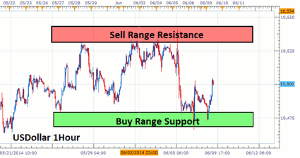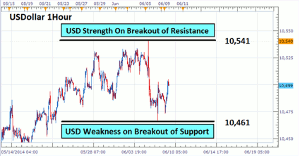With the US Dollar Index ranging post-NFP, traders have two ways to approach the US dollar, based off of strength or weakness, says Walker England of DailyFX.com.
Even after last week’s NFP (Non-Farm Payroll) event, the Dow Jones FXCM US Dollar Index has continued trading in a sideways range. This has left many traders considering their options when it comes to trading forex’s traditional major currency pairs, including the EUR/USD. Today we will look at two ways to trade the US Dollar Index, and how developing a trading strategy around the US dollar can translate into a trading bias on other traditional forex majors.
So let’s find out how traders can approach the US dollar for this week’s trading. Let’s begin!
US Dollar Trading Range

(Created using FXCM’s Marketscope 2.0 charts)
Click to Enlarge
Trade the Range
First off, when prices are ranging, traders should consider trading the range! Traders looking to trade the underlying US Dollar Index will look to buy range support in the event of US dollar strength. Limit orders on new buy positions can look to take profit at resistance. Conversely, if the range is set to continue, traders can replicate the process by selling resistance and taking profit as price moves toward support.
Traders can also use the range to their advantage when deciding how to approach traditional US dollar-based pairs. If traders are looking for a bounce of the US Dollar Index, this would signal underlying US dollar strength. Knowing this, traders can sell pairs such as the EUR/USD and GBP/USD. Conversely, in the event that US dollar weakens at resistance, traders can look to capitalize buy buying pairs such as the AUD/USD.
EUR/USD Trading Blocks

(Created using FXCM’s Marketscope 2.0 charts)
Click to Enlarge
Trade a Breakout
The next way we can trade the US Dollar Index is through the use of a breakout methodology. Traders looking to trade in this manner may do so through the use of entry orders. Traders will look to set entries above resistance to buy a breakout towards higher highs. As well, traders will likewise look to sell the market in the event that price moves through support.
Again, these moves will also correlate to the moves of the forex majors. If the US Dollar Index breaks out below support, this is an indication of US dollar pairs gaining strength on US dollar weakness. In the event of this scenario, traders could look to capitalize on buying the AUD/USD, GBP/USD. Conversely, if the US Dollar Index breaks towards higher highs, this would symbolize US dollar strength. Traders would then look to sell US dollar based pairs such as the EUR/USD!
As you can see, the US Dollar Index can be extremely helpful when planning a trading strategy.
By Walker England, Trading Instructor, DailyFX.com


















